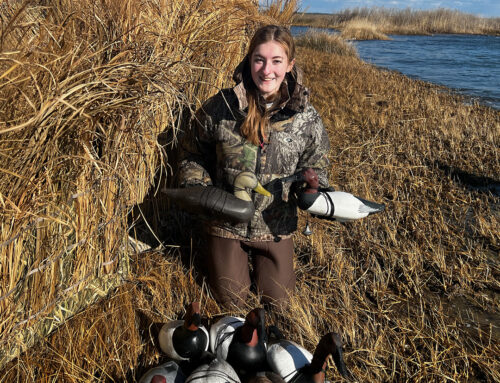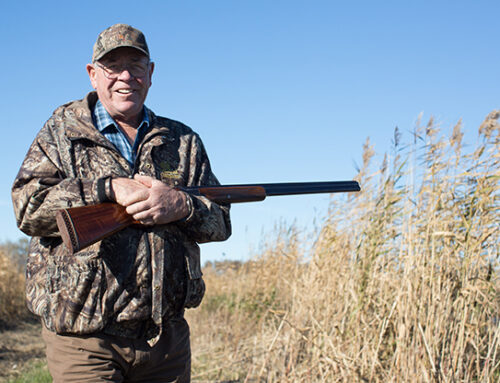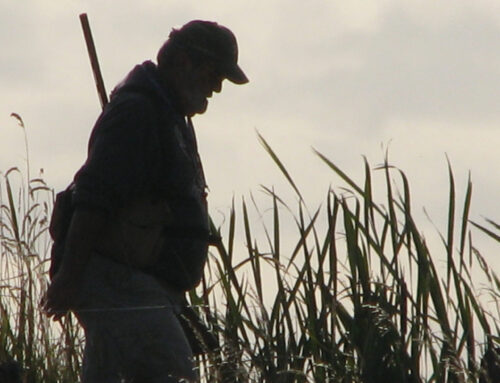Exciting seasons ahead for East Coast and West Coast goose hunters

As Delta’s president Dr. Frank Rohwer so often says, “Hunters don’t shoot the spring breeding population, we shoot the fall flight so it’s breeding success that really matters to hunters.” Those core words of wisdom are as true with geese as they are for ducks.
“Temperate-breeding Canada geese nesting in southern Canada and the lower 48 United States are generally far less affected than ducks by the widespread dry conditions, so their numbers have held up well through the last couple of years. Those birds showed up as usual in 2022, but the late stay of winter-like weather may have depressed some production,” said Delta’s waterfowl scientist Dr. Chris Nicolai, a leading goose expert. “However, things were pretty much status quo for the northern breeders this year with some really, really bright spots, as well.”
Two groups of hunters who will be particularly happy are Atlantic Flyway Canada goose hunters and Pacific Flyway light goose hunters.
Atlantic Flyway
AP Canada Goose Numbers Up
Biologists define three populations of Atlantic Flyway Canada geese — the North Atlantic Population (NAP), Atlantic Population (AP) and Atlantic Flyway Resident Population (AFRP). However, all three tend to comingle during fall migration — aka “hunting season.” These are the birds hunters from the maritime provinces south to the renowned Delmarva Peninsula and beyond to the Carolinas look to for their harvest.
Frankly, it has been awhile since devoted AP goose hunters have had much to cheer about, but this year they do — finally!
Nicolai said, “AP Canada geese are showing their highest populations since 2015. They are actually up 37 percent since the last survey in 2019. Along with Eastern mallard numbers being up, those are some really bright spots for Delta’s Atlantic flyway hunters.”
While these numbers portend well for good hunting in the seasons immediately ahead, the increased breeding population of AP geese on the scene this spring as well as the likely strong production during the breeding season may give potential for liberalization of bag limits and season lengths in future years for Atlantic Flyway states.
Pacific Flyway
“It’s a great, great time to be a Pacific Flyway snow goose hunter!” Nicolai said. “There’s news from Wrangel Island, which produces a major portion of the West Coast light goose migration, that will create some real excitement out there!” In addition, last year’s estimate of Aleutian cackling geese were at another all time record which continues to be exciting news for the once endangered goose sub-species.
Wrangel Island
This Russian island is the breeding ground of a large snow goose colony contributing primarily to migrations down the Pacific Flyway. And the news from there is off-the-charts optimistic for light goose hunting for West Coast hunters. Nicolai said, “It doesn’t get better than Wrangel Island. They are in their third year of exponential growth. They completely blew up again. It appears 2022 set a new population record on this nesting ground for snow geese. That beats the old record set in 2020 which dipped just slightly to the all-time Number Two in 2021.”
Yukon Delta, Alaska
Goose production from this region primarily benefits the Pacific Flyway. Bryan Daniels of the Yukon Delta National Wildlife Refuge shared with Nicolai that high numbers of arctic foxes and indications of significant impact of Highly Pathogenic. Avian Influenza A (HPAI) point to a bleak outlook for the black brant, minima cackling geese, white-fronts and Taverner’s cackling geese that are normally abundant on this breeding ground.
North Slope of Alaska
This area produces good numbers of black brant and Central Flyway white-fronted geese, plus a small number of snow geese, notably the Ikpikpuk River and Colville River delta colonies which each usually has in the neighborhood of 20,000 snow goose nests. However, according to sources there, the returning breeding populations were greeted by late spring conditions that likely negatively impacted production to at least some degree.
Central and Mississippi Flyways
With widely ranging reports from the artic and fairly steady statistics on temperate breeding Canada geese it seems likely that hunting for Canada, cackling, snow, Ross’, and white-fronted geese in the Central and Mississippi Flyways should range from average to good. Some areas could see outstanding local hunting for homegrown honkers throughout the long seasons on the big birds.
Northern-nesting Geese
Goose population counts and banding programs were back on the scene across the artic after a two-year Covid-19 hiatus. Like resident geese in the Lower 48, it appears that bird estimates and nesting success ranged the gamut from spectacular and record-setting to dismal and nearly non-existent. The results published in the 2022 USFWS Waterfowl Population Status report and Nicolai’s deep network of contacts support the roller-coaster predictions.
Canadian Arctic Areas
Banks Island, Queen Maud Gulf, Southampton Island, Baffin Island and Western Hudson Bay are all vital nesting grounds for mid-continent (Central and Mississippi Flyway) lesser snow geese as well as brant, Ross’s geese, cackling geese and mid-continent white-fronts. The reports Nicolai has received on these Canadian artic areas is a mixed bag, literally on a breeding-ground-by-breeding-ground basis.
He said, “Reports were great from South Hampton Island, Baffin Island, and Western Hudson Bay. The birds showed up and production looks in these areas looks to be well above average.”
The news from Queen Maud Gulf and Bylot Island appears to be as dreadful as the others are optimistic — likely worse. Nicolai said, “Queen Maud Gulf was utterly destroyed for some reason. The guys who went up there had to work hard just to find any geese let alone capture them. It’s a wonder that one of the biggest breeding aggregations ever seems to have just disappeared off the earth!”
Bylot Island was also deemed to have had “very poor” production this season. Nicolai said, “It seems to have been the poorest in at least 35 years of monitoring by the research team led by Gilles Gautier there.”
Resident Canadas A Mixed Bag
Spring counts of resident-nesting Canada geese range from record-setting too steady to decreased by as much as one third in the states conducting surveys. However, most of the northern tier states and lower Canadian provinces reported very late thaws and warm weather. Canada geese typically begin nesting earlier than ducks, and the late spring in many areas may have impacted production.
The 2022 North Dakota estimate set an all-time record, continuing the growth trend for at least the third consecutive year. The 2021 North Dakota estimate of 379,786 resident Canadas was up 13.3 percent from 2020 and made it the second highest NDGFD estimate ever. Only the 2018 statewide estimate was a couple thousand birds higher, but the 2022 count tops them all. Off-setting the optimism of an all-time high breeding population is the likelihood that production was negatively impacted by the late spring conditions. North Dakota Game and Fish migratory game bird supervisor Mike Szymanski said, “Goose production is down considerably, affected quite a bit by the blizzard that happened in mid-April. However, we still have a lot of Canada geese on the landscape.” Ultimately that will probably mean excellent hunting, once again, for homegrown honkers in North Dakota this season.
Minnesota suspended its spring waterfowl counts in 2020 and 2021 due to Covid-19, but reinstated them in 2022. This spring’s Minnesota survey showed a population estimate of 115,000 which was up 4 percent from the 2019 estimate, but 20 percent below the 10-year average. It’s worth noting that Minnesota’s survey was impacted by the late arrival of “normal” spring conditions in that the technicians encountered virtually no leaf out and emergent vegetation. That accounted for the lowest “visibility correction factor” on record (1988-2022). All goose broods observed were seen in the southern half of the state — more indications that resident goose production was likely low due to the late spring.
In Wisconsin, the 2022 population estimate for Canada geese is 180,340 — up 3.3 percent from 2021 and continuing at a whopping 68 percent above the long-term, 36-year mean. These counts again add to a long-term trend indicating a continued, gradual increase in the homegrown Canada goose population. These numbers are important to Badger State hunters, as it’s estimated more than 60 percent of the Canada geese taken there are resident-hatched birds.
In Michigan, the estimated population of resident-nesting Canada geese was down 34 percent from the Department of Natural Resources’ 2021 count. This spring’s estimated 196,204 birds put the number 16 percent below the long-term average and 28 percent below the 10-year average. However, the DNR is considering the current population a management success as it’s the first time since 2014 Canada goose numbers are within Michigan’s long-term desired abundance range of 175,000-225,000 birds. The state continues to make full use of hunting season days and daily limits within Federal regulation frameworks, and the decision is supported by high goose abundance and productivity over the last five years.
In the Pacific Flyway, this year’s Oregon survey reported 44,711 breeding Canada geese. That’s down nearly 17 percent from 2021 survey, but remains up more than 31 percent from the state’s long-term average of 262,760. This is despite drought conditions considered “severe, extreme or exceptional” for several years over large portions of the state. Oregon did not conduct a survey in 2020 due to Covid-19 protocols.
The ongoing drought conditions in California appear to be continuing to negatively impact locally-reared Canada goose numbers there. Surveys were suspended during 2020 and 2021 due to Covid-19, however 2022 population estimates revealed another 10 percent decline from the 2019 statewide count, but did manage a gain of 4 percent over 2019 against the Golden State’s long term resident Canada goose population average.
Hope for the Season Ahead
Whether goose hunting in your neck of the woods is forecast to be fair to middlin’, good, great or off-the-hook, chances are you be out there — enjoying every minute — because you should be. Remember, you can’t smoke ’em if you don’t shoot ’em, and you can’t shoot ’em if you don’t hunt ’em. And something else to remember this season — share the fun with a newcomer. They’ll have a ball and you’ll enjoy the hunt that much more seeing it through their eyes and first-time experiences. — Bill Miller






Leave A Comment